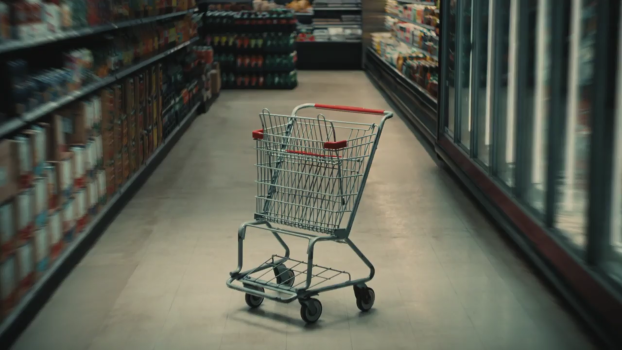‘There are,’ says Philip George, ‘only so many times you can clean your ears.’ Now, for most of us – with the exception, of course, of the ear fetishists – that’s not much of a dilemma. But for George, it’s an issue of overriding concern.
As group account director with Toronto-based Ogilvy & Mather, George handles the Q-tips brand for Lever Pond’s. In this capacity, he’s responsible for helping the venerable cotton swab maintain and build market share – not an easy task, given the limiting factor described above.
The solution? It’s simple – almost as simple as the product itself, in fact: If folks aren’t going to spend any more time cleaning ears than they already do, then you’ve got to let them know that Q-tips are good for a lot more than just cleaning ears.
‘We wanted to build an even stronger brand and sell more product,’ George explains. ‘We wanted to expand our share by getting users to use more Q-tips. And one way to do that was to expand the range of uses for the brand.’
So successful has this effort been that the agency is now doing work on the brand for the U.S. market as well.
The Q-tips brand, it should be noted, wasn’t exactly floundering when Lever Pond’s and O&M began laying the groundwork for this new strategy four years ago. It commanded approximately 67% of the Canadian market for cotton swabs, and enjoyed high levels of consumer trust and confidence.
Q-tips had really defined the category – and therein lay the problem. The brand name was in danger of becoming a generic term for any cotton swab. And that created opportunities for competing private label and store brand products – priced anywhere from 75 cents to a dollar less – to step in and steal away share.
‘We needed to reverse this,’ George says. ‘We needed to create a far stronger positioning for the brand in the marketplace.’ And this needed to be done on a fairly modest budget, since Q-tips is not considered a core brand for Lever Pond’s.
For years, Q-tips advertising had been aimed primarily at mothers, focusing on the use of the product for baby care. Research, however, indicated that only 10% of Q-tips purchasers actually use the product on their babies.
‘All kinds of people use it for all kinds of different things,’ says Janet Kestin, creative director with Ogilvy & Mather. Among those uses: applying makeup, dusting, touching up a paint job or cleaning the heads on a VCR.
Armed with this knowledge, the Q-tips team began to map out a new strategic direction that would shift the brand away from its concentration on ‘babies and ears.’ The first step would be a campaign designed to reassert the superiority of the product and help consumers understand why they should pay a premium price for it. That would be followed by a campaign highlighting some of the alternative uses to which Q-tips can be put.
‘We wanted to start out by building upon our existing strengths,’ George says. ‘First, you get people nodding their heads that Q-tips are a better quality product. Once you do that, then it’s easier to go into the ‘extended use’ phase of the campaign. If we’d gone straight into communicating extended uses, we would have done more for the category than the brand.’
The ‘superiority’ campaign ran in Canadian consumer magazines in 1997. The ads (created by art director Marissa Mastenbroek and writers Trent Burton and Brian Smith), featured cutouts in the distinctive shape of a Q-tip, behind which appeared images such as roses and clouds – each intended to denote one of the product’s attributes: gentleness, softness and so on.
Along the bottom ran a single line of copy, ending with the tag, ‘So if you want a Q-tip, buy a Q-tip.’
By the summer of 1998, the team was ready to kick off the ‘extended use’ phase of the campaign. In order to create some fanfare, O&M worked with public relations firm Langdon Starr Ketchum on a major publicity event tied to the brand’s 75th anniversary.
The event took place in July at Toronto’s Union Station. Stickers featuring the slogan ‘One more place that could use a Q-tip’ were plastered all over the station in hard-to-reach spots. Giant inflatable Q-tips were attached to the building’s columns. Hot dog and flower vending carts were provided with Q-tips umbrellas for the day, and rickshaw drivers were enlisted to hand out free product samples.
A teaser campaign ran in radio, newspaper and out-of-home the week prior to the event. That was followed by a radio campaign and contest promoting alternative uses for Q-tips.
The Union Station event, which generated media coverage across the country, was an innovation born of necessity, Kestin says. Simply put, there wasn’t the money available at the time to mount a high-profile advertising campaign.
‘We wanted to launch this new direction with a bang,’ she says. ‘But it can be expensive to do an ad campaign. In this case, we thought our money would be better spent if we did just a small amount of advertising, and created a fuss some other way. When you’ve got a smaller client with a small amount of money, you really have to be doubly clever.’
A national campaign to advance the extended use strategy did finally launch in out-of-home late last spring. The billboards and transit ads (created by Mastenbroek and writer Marcus Sagar), feature split images designed to resemble a children’s flip book. The end of a Q-tip appears on one side of each board, paired on the other by a variety of household implements: a makeup brush, a feather duster, a paintbrush and so on. The copy reads, ‘All purpose Q-tips.’
Simplicity has been the watchword for all of the recent creative work on the Q-tips brand, Kestin says. The campaigns have employed visual solutions, rather than relying heavily on copy.
‘We went as bare-bones as humanly possible,’ she says. ‘My own view is that consumers like a little puzzle – the ads they enjoy are the ones that engage their intelligence just a bit.’
‘It’s our belief that if you can say something in a simple way and get the point across quickly, you should do it,’ affirms Rob Guenette, who was category director, hair care and toiletries with Lever Pond’s when the Q-tips strategy was conceived and developed (he joined Molson Breweries at the start of this year). ‘I think we were able to achieve some stuff that was artistic, engaging and interesting, and still got the strategy across.’
George, for his part, says some of the creative and media choices have been unconventional for the personal care products category, and credits the client with a willingness to take risks.
In addition to the advertising, Lever Pond’s has developed a number of promotional programs to support the brand. Samples of some of the company’s other major personal care brands, such as Vaseline Intensive Care lotion and Thermasilk shampoo, have been included in-pack. And, for the 75th anniversary, a special commemorative tin was packaged with large-size boxes of Q-tips, to encourage incremental consumption.
All told, Guenette says, Q-tips sales have increased by more than 60% since Lever Pond’s made the initial shift to the new strategy four years ago.
Results like these did not escape the attention of Guenette’s colleagues at Unilever in the U.S. So impressed were they, in fact, that they engaged O&M in Toronto to handle some work on the brand south of the border.
The agency’s initial effort for the U.S. market will promote the use of Q-tips for makeup application. The ads, which are scheduled to begin running in fashion and beauty magazines in the first half of this year, employ the same basic creative strategy as the ‘flip book’ campaign.
Some valuable lessons can be drawn from the whole Q-tips experience, Guenette says. With the application of a little creative thinking, even the most seemingly humdrum of brands can be made exciting. And it doesn’t take a colossal budget to pull off this feat, either.
Plans for 2000 are now in the development phase. Guenette says the challenge for the brand team will be finding ways to keep the creative approach fresh. ‘You can’t afford to get predictable or formulaic,’ he says. ‘The question becomes: How do you surprise the consumer again?’
George agrees. ‘We’ve taken the brand a long way. And now we want to keep the momentum going.’
– Through the digital back door: Consumer demand for online health information spells major changes for drug manufacturers
– Regulations hamper Web efficacy p.27
– Pharmaceutical ads could use creative Rx p.29
– Greens+ business an organic success: Sales of nutritional supplement have grown by leaps and bounds since it entered the mass market p.30























